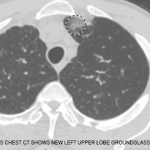
ibreakstock / shutterstock.com
SAN DIEGO—At the 2017 ACR/ARHP Annual Meeting this past November, three researchers discussed the latest ANCA-associated vasculitis (AAV) research, including studies on AAV pathogenesis, therapies and remission maintenance.
In the Philip Hench, MD, Memorial Lecture, J. Charles Jennette, MD, chair in pathology and laboratory medicine at the University of Carolina at Chapel Hill in Chapel Hill, N.C., said the pathogenesis of AAV involves a complex series of events that evolve over time, and the treatment approach is growing ever more sophisticated.
Dr. Jennette began studying the disease more than 30 years ago. In his talk, he traced his experience with the disease back to a 15-year-old patient he first encountered in 1985. The patient had severe arthritis, severe pulmonary hemorrhage, glomerulonephritis and purpuric rash. The patient did not fulfill diagnostic criteria for the types of glomerulonephritis and vasculitis that were known at the time. With no diagnosis and no known cause, a confident decision about treatment could not be made.
Dr. Jennette and his major collaborator, Ronald J. Falk, MD, chair of medicine at UNC, made important discoveries about the antigen specificity and disease associations of this new class of antibodies, which came to be known as anti-neutrophil-cytoplasmic autoantibodies (ANCA). Since then, the classification criteria for AAV has deepened, along with insights into its pathogenesis, now known to involve ANCA-induced activation of primed neutrophils resulting in acute inflammation and necrosis, and chronic inflammation and scarring.
Today, Dr. Jennette said, treatment strategies have been influenced by the understanding of AAV pathogenesis.
“B cell-directed immunosuppressive therapy must be accomplished to initiate remission and to sustain it in the long term,” he said. Therapy must also specifically interrupt the acute inflammatory “amplification loop” present in patients with active AAV, he said; that is, it must break the cycle in which the activation of neutrophils leads to activation of the alternative complement pathway, which leads to even more neutrophil activation.
Anti-macrophage and anti-T cell therapy must also be incorporated for the disease’s subacute phase, along with anti-fibrotics and immunomodulators, to sustain remission.
Treatment options continue to improve, Dr. Jennette said, with the introduction of novel therapies targeting specific components of the pathogenic process.
Promising results have been seen with CCX168 (i.e., avacopan, an oral inhibitor of complement component 5a (C5a) receptor), which disrupts the disease’s amplification loop and limits steroid use.1 In a randomized trial with 63 patients, the drug was found to be statistically non-inferior to standard treatment with steroids, with faster improvement of disease activity, according to the Birmingham Vasculitis Activity Score (BVAS). The drug is now in Phase 3 clinical trials. (Note: Dr. Jennette has received research support from the manufacturer, ChemoCentryx.)
Dr. Jennette said new approaches to treatment have been informed by decades of work to better understand AAV’s pathogenesis. “With our understanding of pathogenic mechanisms, we may think of targets for therapy we would not have thought of otherwise.”
GPA Remission Research
In another session focused mainly on maintaining remission in granulomatosis with polyangiitis (GPA), Christian Pagnoux, MD, associate professor of rheumatology at Mount Sinai Hospital in Toronto, said the data are not always clear cut, putting the onus on clinicians to decide what’s best for their patients.
“There are lots of unanswered and lingering questions, and a lot of controversy as well,” he said. “Different groups or persons may have different opinions.”
Conventional immunosuppressive treatments for GPA remission maintenance over the past 20 years have included azathioprine (AZA), methotrexate (MTX) and mycophonelate mofetil (MMF). But even though short-term relapse rates remain low, relapse-free survival occurs for only about 30% of patients on these treatments at about three years, Dr. Pagnoux said.
“That’s why these are far from being the ideal treatment, at least when they are given for 12 months,” he said.2
In a small German study, leflunomide was found to work better than methotrexate, making it a potential option, at least for patients who can’t tolerate methotrexate or azathioprine.3
There have been confusing findings on maintenance therapy for patients who received rituximab induction. A study out of Cleveland Clinic found that those treated with AZA, MTX or MMF had a relapse rate of 35% at 18 months compared with 61% for those not given maintenance treatment.4 But a study out of Cambridge showed maintenance didn’t have this effect: “It was as if this conventional treatment had become futile or too weak to achieve anything and to maintain remission further when given shortly after rituximab,” Dr. Pagnoux said. These were both retrospective studies.
In the MAINRITSAN trial, systematic rituximab infusions produced good results compared to azathioprine in patients who achieved remission, and researchers await more results from the RITAZAREM trial.5
Questions also remain over how long patients should remain on maintenance therapy, Dr. Pagnoux said. In the REMAIN study, patients on azathioprine and low-dose prednisone for four years had a lower relapse rate than those whose maintenance treatment was stopped after two years.6 But follow-up data from six European studies found that although stopping maintenance at 12 months was associated with a higher relapse rate, there was no benefit to continuing past 18 months.7
To help answer these questions, Dr. Pagnoux said, “We need randomized controlled trials.”
More recently, researchers assessed patients who had remission induced with rituximab or cyclophosphamide and were then randomized after azathioprine treatment to either the monoclonal antibody belimumab or placebo. There was no significant difference between the groups in time to first relapse.8
The search for biomarkers to help individualize treatment remains a worthwhile effort, he said, but for now GPA or MPA hold the most important distinction, with GPA patients tending to feature a higher relapse risk.
“I think we have to admit that at this time, the most practical predictor of relapse is a basic, simple, clinical one,” he said.
Imperfect information leaves clinicians to make sometimes difficult decisions, he said. What, for example, should clinicians do about patients whose ANCA titers are persistent or increase during follow-up, and who historically relapse at about a 60% rate compared with 40% for those who stay ANCA negative?
“Is that difference enough to adjust, qualify or adapt the treatment? I’ll leave that to you to make your own decision,” he said. “The dream to individualize treatment based on genetics or some other biomarker is a commendable dream and, hopefully, will come to fruition soon, in a cost-effective manner.”
EGPA Treatment Research
Eosinophilic granulomatosis with polyangiitis (EGPA), or the Churg-Strauss syndrome, is a rare and little-studied form of ANCA-associated vasculitis, but one that should remain on the radar screen of rheumatologists, said Michael Wechsler, MD, director of the National Jewish Health Cohen Family Asthma Institute in Denver.
“The key issue for rheumatologists to recognize is that when you see eosinophilia [with counts of 1,000 or higher], you should think about EGPA,” he said.
EGPA encompasses a constellation of symptoms, including asthma, peripheral blood eosinophilia, mononeuropathy or polyneuropathy, pulmonary infiltrates, paranasal sinus abnormalities, extravascular eosinophils and ANCA positivity.
The disease often starts as an allergic rhinitis that becomes asthma, progresses to eosinophilic infiltration in the organs and then progresses to necrotizing vasculitis and granuloma formation. He tells patients to be wary of organ involvement (including neuropathy or GI symptoms) when he sees someone with asthma and eosinophilia. “I question them very heavily,” he said.
Steroids can usually control symptoms, but not always, and of course, they come with a litany of side effects even when they do work, Dr. Wechsler said. Other EGPA therapies are needed.
A 2017 study found that adding azathioprine to steroids didn’t reduce treatment failure, relapse rate or steroid use, and didn’t improve asthma or sinus problems.9
Dr. Wechsler has been studying use of the IL-5 inhibitor mepolizumab in EGPA. “I think it makes sense to target the eosinophils directly as opposed to more broad bone-marrow suppression with cytotoxic agents like cyclophosphamide and azathioprine,” he said.
In a randomized trial published in 2017, 130 patients were randomized in nine countries to 300 mg of subcutaneous mepolizumab or placebo once a month for a year.10 Patients were, on average, 48 years old, and 40% of the subjects enrolled were men, with 20% having been ANCA positive at some point in their lives and taking 11–12 mg of corticosteroids per day.
Researchers found that 53% achieved remission for at least some period of time, compared to 7% for placebo (P<0.01). Remission at 36 and 48 weeks was 32% in the active group, and 3% in the placebo group (P<0.001).
Mepolizumab cut EGPA relapses in half. They found that 37% had asthma-related relapse, 35% had sino-nasal relapse and 43% had vasculitis relapse, Dr. Wechsler said.
More questions remain as research continues, he said. “Can anti-IL-5 therapy be used as first-line therapy?” he said. “Can it be used in acute EGPA, and can it be given without corticosteroids?”
Thomas R. Collins is a freelance writer living in South Florida.
References
- Jayne DRW, Bruchfeld AN, Harper L, et al. Randomized trial of C5a receptor inhibitor Avacopan in ANCA-associated vasculitis. J Am Soc Nephrol. 2017 Sep;28(9):2756–2767.
- De Groot K, Rasmussen N, Bacon PA, et al. Randomized trial of cyclophosphamide versus methotrexate for induction of remission in early systemic antineutrophil cytoplasmicantibody-associated vasculitis. Arthritis Rheum. 2005 Aug;52(8):2461–2469.
- Hazlewood GS, Metzler C, Tomlinson GA, et al. Non-biologic remission maintenance therapy in adult patients with ANCA-associated vasculitis: A systematic review and network meta-analysis. Joint Bone Spine. 2014 Jul;81(4):337–341.
- Azar L, Springer J, Langford CA, et al. Rituximab with or without a conventional maintenance agent in the treatment of relapsing granulomatosis with polyangiitis (Wegener’s): A retrospective single-center study. Arthritis Rheumatol. 2014 Oct;66(10):2862–2870.
- Guillevin L, Pagnoux C, Karras A, et al. Rituximab versus azathioprine for maintenance in ANCA-associated vasculitis. N Engl J Med. 2014 Nov 6;371(19):1771–1780.
- Karras A, Pagnoux C, Haubitz M, et al. Randomised controlled trial of prolonged treatment in the remission phase of ANCA-associated vasculitis. Ann Rheum Dis. 2017 Oct;76(10):1662–1668.
- de Joode AAE, Sanders JSF, Puechal X, et al. Long-term azathioprine maintenance therapy in ANCA-associated vasculitis: Combined results of long-term follow-up data. Rheumatology (Oxford). 2017 Nov 1;56(11):1894–1901.
- Jayne D, Blockmans D, Luqmaani R, et al. Efficacy and safety of belimumab in combination with azathioprine for remission maintenance in granulomatosis with polyangiitis and microscopic polyangiitis: A multicenter randomized, placebo-controlled study [abstract]. Arthritis Rheumatol. 2017;69(suppl 10).
- Puechal X, Pagnoux C, Baron G, et al. Adding azathioprine to remission-induction glucocorticoids for eosinophilic granulomatosis with polyangiitis (Churg-Strauss), microscopic polyangiitis, or polyarteritis nodosa without poor prognosis factors: A randomized, controlled trial. Arthritis Rheumatol. 2017 Nov;69(11):2175–2186.
- Wechsler ME, Akuthota P, Jayne D, et al. Mepolizumab or placebo for eosinophilic granulomatosis with polyangiitis. N Engl J Med. 2017 May 18;376(20):1921–1932.


